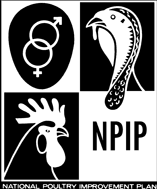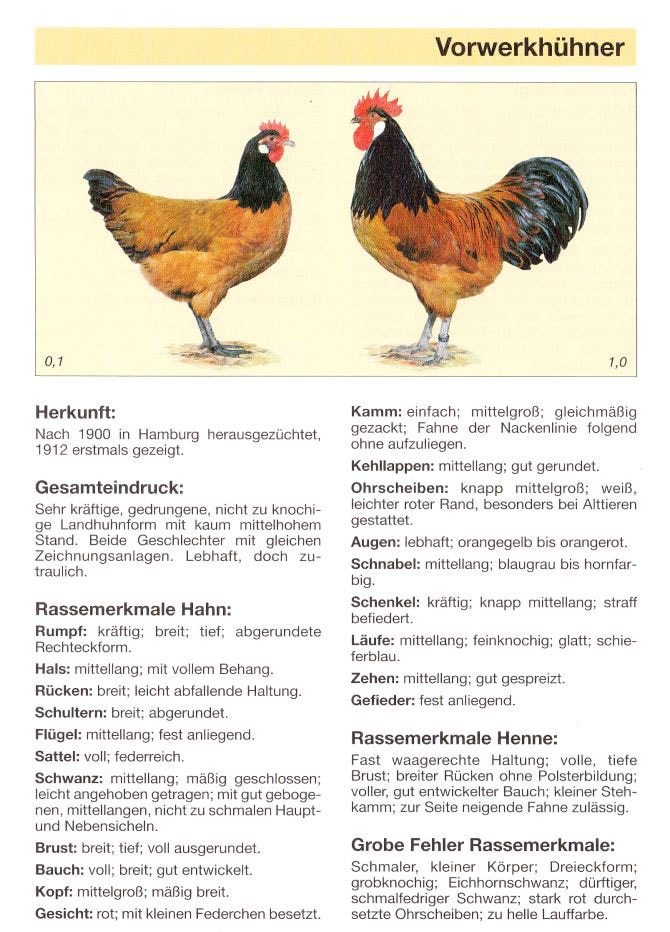The "Vorwerkhuhn" originated in Hamburg by Oskar Vowerk in 1900, and was first shown in Hanover in 1912 and standardized in 1913. The aim was to provide a middle-weight economical utility fowl with good nature, lively and not timid. A conservation effort to preserve this breed started in 1999 with just 9 dedicated breeders - and now these amazing birds have come to the United States of America. UK refers to these birds as Golden Lakenvelders except for Germany which call them Vorwerks. They were brought over to the U.S. as marketed using this German Nickname in an attempt to make them more valuable. Many American breeders continue to try to seperate it into it's own breed, but the rest of the world considers them one breed. Even the original German Conservation Page refers to Silver as LakenVelder - Golden as Vorwerk. ( Original German Society for Vorwerks)
|
Vorwerks:
|
Our flock are the first generation offspring from Vorwerks that were imported in 2017 by Greenfire, however - we do not buy into the hype that Vorwerks are some seperate breed from Golden Lakenvelders - as we own both GFF imports AND Golden Lakenvelders, though we keep them seperated.
After extensive study and research - we reached the conclusion that Lakenvelders have three varieties in the UK: Gold, Blue, Silver. Silver are known as just Lakenvelder. Gold are known in Germany as Vorwerk, the rest of EU as Golden Lakenvelder and the Netherlands/Dutch have a very rare almost extinct version called "Blue Marked" Lakenvelder. |
British Poultry Standards - Vorwerk (Large Fowl)
Classification: Light : Rare
Egg Color: Cream to Tinted Weight Roo: 5 1/2 - 7lbs (2.5-3.2kg) Hen: 4 1/2-5 1/2 lbs (2 - 2.5 kg) General CharacteristicsRooCarriage: Very Powerful, compact utility shape, carriage low rather than high, not too much bone, markings the same in both sexes. Lively but not timid.
Type: Body of considerable size, as broad and deep as possible like a rounded rectangle, back broad, slightly sloping with a full saddle. Breast broad, deep and well rounded. Wings: Closely carried. Tall moderately tight, held at a lowish angle with well rounded sickles of moderate length. Head: Medium sized and moderately broad. Face covered with small feathers. Beak: Greyish-blue to horn. Comb: Single, of medium size at the most, with four to six serrations. Red. Wattles: Medium length, well rounded. Red Lobes: Barely average size, white. Eyes: Alert. Orange or Orange-red. Neck: Of moderate length with full hackle and carried fairly upright, proudly. Legs and Feet: Slate blue. Toes: four, small close fitting scales. Thighs: fleshy and tightly feathered Plumage: Close fitting, glossy, velvety hackles. Handling: Farm as befits an active forager. |
HenGeneral characteristics are similar, allowing for the natural sexual differences.
Back to be broad with almost no cushion. The latter part of the small comb may bend slightly to one side. |
Color
Male plumage: head, hackle, and tail should be velvety black. Body deep buff, undercolor grey. Wing secondaries buff; primaries dark grey to black. Saddle buff with light striping. Legs slate.
Female plumage: Hackle black with slightly buff lacing permitted at the back of the head. Body and secondary wing flights buff; primaries greyish-black and buff mixed. Visible parts of the main tail black with the tail furnishings partly laced with buff. Undercolor grey.
Female plumage: Hackle black with slightly buff lacing permitted at the back of the head. Body and secondary wing flights buff; primaries greyish-black and buff mixed. Visible parts of the main tail black with the tail furnishings partly laced with buff. Undercolor grey.
Serious Defects
Body too narrow or too light. Carriage too high. Coarse bone. High Tail. Lobes too red. Pale legs.
Roos: hackle unduly buff or grey, saddle nearly black.
Hens: lack of black in neck or tail, and undue spangling in body feathers.
Roos: hackle unduly buff or grey, saddle nearly black.
Hens: lack of black in neck or tail, and undue spangling in body feathers.
Standards cited from the British Poultry Association breed standards of perfection for Vorwerks.
Sources: http://www.sv-vorwerk.de/
Sources: http://www.sv-vorwerk.de/


